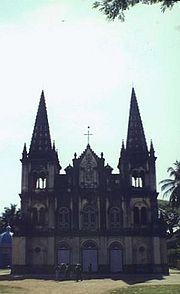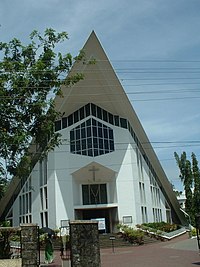| Revision as of 16:53, 26 December 2006 editShyamsunder (talk | contribs)Autopatrolled, Extended confirmed users, Pending changes reviewers153,082 edits →Crypto-Christians in India: rmv POV← Previous edit | Revision as of 11:52, 27 December 2006 edit undoAnandks007 (talk | contribs)Extended confirmed users, Pending changes reviewers, Rollbackers6,318 editsNo edit summaryNext edit → | ||
| Line 24: | Line 24: | ||
| Most Protestant denominations are represented in India, the result of missionary activities throughout the country. Most denominations, however, are almost exclusively staffed by Indians, and the role of foreign missionaries is limited.{{fact}} The largest Protestant denomination in the country is the ], since ] a union of ], ], ], ], and ] congregations with approximately 2.2 million (22 lakh) members ]. A similar ] had 1 million (10 lakh) members. (These churches are in ] with the ].) There were about 1.3 million (13 lakh) ], 473,000 Methodists, and 425,000 ]s ]. ] churches of the Malankara and Malabar rites totalled 2 million (20 lakh) and 700,000 members, respectively. ], another denomination of ], is also a rapidly growing religion in India. It is spreading greatly in northern India and the southwest area, such as ]. The largest indigenous Pentecostal church in India is the ] (IPC). Another prominent group is the Brethrens. They are known in different names ], ], ] etc. | Most Protestant denominations are represented in India, the result of missionary activities throughout the country. Most denominations, however, are almost exclusively staffed by Indians, and the role of foreign missionaries is limited.{{fact}} The largest Protestant denomination in the country is the ], since ] a union of ], ], ], ], and ] congregations with approximately 2.2 million (22 lakh) members ]. A similar ] had 1 million (10 lakh) members. (These churches are in ] with the ].) There were about 1.3 million (13 lakh) ], 473,000 Methodists, and 425,000 ]s ]. ] churches of the Malankara and Malabar rites totalled 2 million (20 lakh) and 700,000 members, respectively. ], another denomination of ], is also a rapidly growing religion in India. It is spreading greatly in northern India and the southwest area, such as ]. The largest indigenous Pentecostal church in India is the ] (IPC). Another prominent group is the Brethrens. They are known in different names ], ], ] etc. | ||
| During the twentieth century, the fastest growing Christian communities have been located in the northeast, among the ]s, ]s, ], and other hill tribes. Today Christians are most prevalent in the northeast (secessionist movements in a few states such as ] are demanding an independent Christian-majority entity), and in western states such as Kerala and ]. Indian Christians have contributed significanly to and are well represented in various spheres of national life. They are currently chief ministers of the states like ] , ], ], ], ] and were chief ministers earlier of ], ] and ]. In the powerful election committee of the ruling ] party they take four out of twelve places. | During the twentieth century, the fastest growing Christian communities have been located in the northeast, among the ]s, ]s, ], and other hill tribes. Today Christians are most prevalent in the northeast (secessionist movements in a few states such as ] are demanding an independent Christian-majority entity), and in western states such as Kerala and ]. Indian Christians have contributed significanly to and are well represented in various spheres of national life. They are currently chief ministers of the states like ] , ], ], ], ] and were chief ministers earlier of ], ] and ]. In the powerful election committee of the ruling ] party they take four out of twelve places. Since Affirmative action/Job reservation is not awarded to Christian Lower caste people, a large number of Christians report themselves as Hindus in the census. So according to the 2001 census, there are only 24,080,016 Christians in India, comprising 2.341% of the total population. But data from various christian organizations operating in India indicate that 5.874% of Indian population is Christian(60,424,407){Note: Figure is the sum of total church membership in India. Figure doesnot includes unaffiliated persons and | ||
| doublecounts people who are affiliated to more than one denomination. People who believe in two religions(say X'ianity & Hinduism) simultaneously are taken as X'ians. If the census figure for X'ians is more than total church affiliation in any state, then the census figure is taken into account for that state.} | |||
| {{Seealso|Roman Catholicism in India|Church of North India|Church of South India}} | {{Seealso|Roman Catholicism in India|Church of North India|Church of South India}} | ||
Revision as of 11:52, 27 December 2006

Christianity is India's third-largest religion, following Hinduism and Islam. It is believed that there have been Christians in India almost for as long as the religion has existed. Christianity underwent major transformation following European contact and British colonisation, because of laws instated that limited the rights of non-Christians. The 2001 census recorded over 24 million (2.4 crore) Indian Christians, comprising 2.3% of the country's population. There are two main regional concentrations of Christian population, namely in South India and among tribal people in East and North-East India.
Early Christianity in India

- Main article: Saint Thomas Christians
According to the 3rd century Acts of Thomas, the first Christians in India were converted by St Thomas the Apostle, who arrived at Kodungallur on the Malabar Coast of India in 52 AD. After evangelizing in Kerala and Tamil Nadu, the Apostle is believed to have been killed at St. Thomas Mount in Chennai and buried on the site of San Thome Cathedral. Members of the Syro-Malabar Church, an eastern rite of the Roman Catholic Church, adopted the Syriac liturgy dating from fourth century Antioch. The Christian community founded by St Thomas has since developed into a number of churches, including Syriac-rite churches in communion with the Roman Catholic, Antiochian Orthodox churches, and 'Nestorian' churches.
The arrival of St Thomas, and the subsequent establishment of the seven and a half churches is viewed with skepticism by historians, as such a tradition is not documented in local literature. However, the theory has never been discounted either, and the Keralites still attribute an apostolic origin to their church.
In the Early Modern Period

Portuguese missionaries, who reached the Malabar Coast in the late 15th century, made contact with the St Thomas Christians in Kerala, and sought to introduce among them the Latin Rite of the Roman Catholic Church. Throughout this period, foreign missionaries also made many new converts to Christianity. Early Roman Catholic missionaries, particularly the Portuguese, led by the Jesuit St Francis Xavier (1506-52), expanded from their bases on the west coast making many converts. Portuguese missionaries sought to convert the entire Hindu population of Goa. St. Francis Xavier, in a 1545 letter to John III of Portugal, requested for an Inquisition to be installed in Goa. However, it was not installed until after eight years of Francis Xavier's death. During the Goa Inquisition under the Portuguese, Hindus were forced to convert and thousands of Hindus in Goa who refused or were suspected of practising heresy were burnt alive in public.Thus present Goa has a huge Roman Catholic population.The undecayed body of Saint Francis Xavier is still on public view in a glass coffin at the Basilica of Bom Jesus in Goa.
Beginning in the eighteenth century, Protestant missionaries began to work throughout India, leading to the growth of different Christian communities. In 1793 William Carey, an English Baptist Minister came to India as a Missionary. He worked in Serampore, Calcutta etc as a missionary. He started the Serampore College. He translated the Bible into Bengali and Sanskrit. He worked until his death in 1834.
Anthony Norris Groves, Plymouth Brethren missionary came to India in 1833. He worked in the Godavari delta area to Tamil Nadu. He worked in India until his death in 1852.
Contemporary situation

The total number of Christians in India according to the 2001 census was 24.08 million (2.40 crores), or 2.3 percent of the population. About 70% of Indian Christians in 1991 were Roman Catholics, including 300,000 members of the Syro-Malankara Church. The remainder of Roman Catholics were under the Catholic Bishops' Conference of India. In January 1993, after centuries of self-government, the 3.5 million (35 lakh)-strong Eastern-rite Syro-Malabar Church was raised to archiepiscopate status as part of the Roman Catholic Church. In total, there were nineteen archbishops, 103 bishops, and about 15,000 priests in India in 1995.
Most Protestant denominations are represented in India, the result of missionary activities throughout the country. Most denominations, however, are almost exclusively staffed by Indians, and the role of foreign missionaries is limited. The largest Protestant denomination in the country is the Church of South India, since 1947 a union of Presbyterian, Reformed, Congregational, Methodist, and Anglican congregations with approximately 2.2 million (22 lakh) members as of 1995. A similar Church of North India had 1 million (10 lakh) members. (These churches are in full communion with the Anglican Communion.) There were about 1.3 million (13 lakh) Lutherans, 473,000 Methodists, and 425,000 Baptists as of 1995. Oriental Orthodox churches of the Malankara and Malabar rites totalled 2 million (20 lakh) and 700,000 members, respectively. Pentecostalism, another denomination of Protestantism, is also a rapidly growing religion in India. It is spreading greatly in northern India and the southwest area, such as Kerala. The largest indigenous Pentecostal church in India is the India Pentecostal Church of God (IPC). Another prominent group is the Brethrens. They are known in different names Plymouth Brethren, Indian Brethren, Kerala brethren etc.
During the twentieth century, the fastest growing Christian communities have been located in the northeast, among the Khasis, Mizos, Nagas, and other hill tribes. Today Christians are most prevalent in the northeast (secessionist movements in a few states such as Nagaland are demanding an independent Christian-majority entity), and in western states such as Kerala and Goa. Indian Christians have contributed significanly to and are well represented in various spheres of national life. They are currently chief ministers of the states like Andhra Pradesh , Nagaland, Mizoram, Manipur, Meghalaya and were chief ministers earlier of Kerala, Goa and Chattisgarh. In the powerful election committee of the ruling Indian National Congress party they take four out of twelve places. Since Affirmative action/Job reservation is not awarded to Christian Lower caste people, a large number of Christians report themselves as Hindus in the census. So according to the 2001 census, there are only 24,080,016 Christians in India, comprising 2.341% of the total population. But data from various christian organizations operating in India indicate that 5.874% of Indian population is Christian(60,424,407){Note: Figure is the sum of total church membership in India. Figure doesnot includes unaffiliated persons and doublecounts people who are affiliated to more than one denomination. People who believe in two religions(say X'ianity & Hinduism) simultaneously are taken as X'ians. If the census figure for X'ians is more than total church affiliation in any state, then the census figure is taken into account for that state.}
See also: Roman Catholicism in India, Church of North India, and Church of South India
Notes
- Kerala History and its makers—A Shreedhara Menon
References
- This article includes material from the 1995 public domain Library of Congress Country Study on India.
- Trec International
- International Mission Board of the Southern Baptist Convention
- American Baptist Convention
- The St. Thomas Christian Encyclopaedia of India, Vol.I (India), Vol.II (Kerala)
See also
- Christianity and Buddhism
- Goa Inquisition
- List of cathedrals in India
- Missionaries in India
- History of Pentecostalism in India
External links
- Christians of Kerala
- Christianity in India
- Christians of Kerala
- A History of the Church of England in India
- Catholic encyclopedia - entry on India
- Mid-India Christian Mission